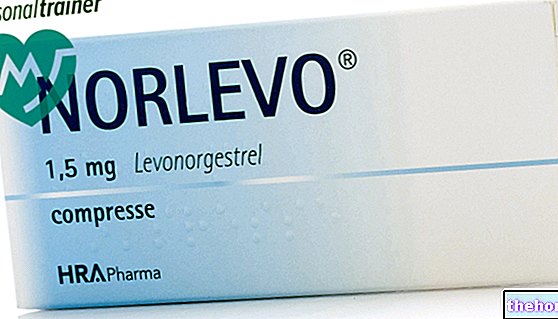Active ingredients: Iron (Ferrous sulphate)
TARDYFER 80 mg prolonged-release tablets
Indications Why is Tardyfer used? What is it for?
Tardyfer is used for the treatment of iron deficiency. This medicine is reserved for use in adults and children over 10 years of age.
Contraindications When Tardyfer should not be used
Do not take Tardyfer
- If you are allergic (hypersensitive) to the active substance (ferrous sulphate) or to any of the other ingredients of Tardyfer, in particular to sucrose. The list of excipients is given in section 6.
- If you have a disease that causes too much iron in your body (e.g. hemochromatosis).
- In case of concomitant parenteral therapy with iron.
- If you have an "intestinal obstruction.
Precautions for use What you need to know before taking Tardyfer
Take special care with Tardyfer
- If you are taking food supplements and / or iron supplements, as high doses of iron (10-20 times the usual dosage) can cause poisoning, especially in children.
- If you have a disease that affects the accumulation and absorption of iron (eg haemolytic anemia, haemoglobinopathy, myelodysplasia)
- If iron deficiency is associated with an inflammatory disease, treatment with Tardyfer will not be effective.
- This medicine contains castor oil and sucrose (see also "Important information about some of the ingredients of Tardyfer").
- Due to the risk of mouth ulceration and tooth discoloration, the tablets should not be sucked, chewed or kept in the mouth, but should be swallowed whole with a glass of water.
Interactions Which drugs or foods can change the effect of Tardyfer
Taking Tardyfer with other medicines
Tell your doctor or pharmacist if you are taking or have recently taken any other medicines, including medicines obtained without a prescription.
Avoid taking Tardyfer with the following medicines:
- Iron given by injection
- Cycline (antibiotics). In case you need to take cyclins, leave an interval of 2-3 hours before taking Tardyfer.
- Chloramphenicol can delay the response to iron therapy.
Dosage adjustment may be required for the following medicinal products. Do not take Tardyfer within 2 hours after a dose of any of the following medicines:
- Penicillamines (used to treat osteoarthritis)
- Methyldopa (used in the treatment of hypertension)
- Levodopa and carbidopa (used to treat Parkinson's disease)
- Antacids (usually used in patients with stomach acid)
- Thyroid hormones (used in the treatment of thyroid disease)
- Bisphosphonates (used in the treatment of osteoporosis)
- Zinc.
If you are taking quinolone antibiotics (eg ciprofloxacin) they should be taken 4 hours before or 4 to 6 hours after taking Tardyfer.
If you are taking anti-inflammatory drugs belonging to the group of non-steroidal anti-inflammatory drugs, they should be taken with food to reduce gastrointestinal irritation and bleeding caused by these types of medicines.
If you are taking cholestyramine (used in patients with high cholesterol levels), it should be taken 4 hours apart from Tardyfer.
Using Tardyfer with food and drink
You should not consume large quantities of tea, coffee, red wine, as they lead to inhibition of iron absorption. Eggs and dairy products such as milk reduce the absorption of iron.
Warnings It is important to know that:
Pregnancy and breastfeeding
Ask your doctor or pharmacist for advice before taking any medicine. When necessary, the use of Tardyfer during pregnancy or breastfeeding may be considered.
Driving and using machines
The use of Tardyfer is unlikely to affect the ability to drive and use machines.
Important information about some of the ingredients of Tardyfer
This medicine contains castor oil. This excipient can cause stomach upset and diarrhea. This medicinal product contains sucrose. If you have been told by your doctor that you have an "intolerance to some sugars, contact your doctor before taking this medicine.
Dose, Method and Time of Administration How to use Tardyfer: Posology
Always use Tardyfer exactly as your doctor has told you. If in doubt, consult your doctor or pharmacist.
The usual dose for adults and children over 10 years of age is: 1 tablet per day (80 mg per day).
In case of more pronounced iron deficiency, the dose can be increased to 2 tablets per day, 1 in the morning and 1 in the evening (160 mg per day).
Method of administration
Oral use.
Swallow the tablet whole. Do not suck, chew or hold the tablet in your mouth. The tablets should be taken with 1 glass of water before meals or during meals depending on stomach tolerability.
Duration of treatment:
The duration of treatment must be sufficient to correct the iron deficiency (anemia) and to restore iron stores; generally 3 to 6 months. Your doctor will inform you about the duration of the treatment.
If you have any further questions, ask your doctor or pharmacist.
Overdose What to do if you have taken too much Tardyfer
If you use more Tardyfer than you should
Ingestion of large amounts of iron can cause poisoning, particularly in young children. If you take too many Tardyfer tablets you may experience vomiting, diarrhea and abdominal pain.
Contact a doctor or the nearest emergency room immediately so that you can receive adequate treatment.
If you forget to take Tardyfer
In case you forget to take one or more doses of Tardyfer, continue the treatment as normal as prescribed by your doctor. Do not take a double dose to make up for a forgotten dose.
Side Effects What are the side effects of Tardyfer
Like all medicines, Tardyfer can cause side effects, although not everybody gets them.
- Frequency not known (cannot be estimated from the available data) Allergic reactions which may include rash, difficulty in breathing, hives.
- Uncommon (may affect up to 1 in 100 people) Edema in the soft tissue of the larynx.
- Common (may affect up to 1 in 10 people) Difficulty passing stools, diarrhea, feeling of fullness and tightness in the abdomen, abdominal pain, black stools, nausea.
- Uncommon (may affect up to 1 in 100 people) Abnormal stools, heartburn, vomiting, inflammation of the stomach lining.
- Frequency not known (cannot be estimated from the available data) Tooth discoloration *, mouth ulceration *.
* In case of incorrect administration, when the tablets are chewed, sucked or kept in the mouth. Elderly patients and patients with swallowing disorders may also be at risk for esophageal lesions or bronchial necrosis if administered incorrectly.
- Uncommon (may affect up to 1 in 100 people) Pruritus, erythematous rash.
If you get any side effects, talk to your doctor or pharmacist. This includes any possible side effects not listed in this leaflet. Side effects can also be reported directly via the national reporting system at https://www.aifa.gov.it/content/segnalazioni-reazioni-avverse. By reporting side effects you can help provide more information on safety. of this medicine.
If any of the side effects gets serious, or if you notice any side effects not listed in this leaflet, please tell your doctor or pharmacist.
Expiry and Retention
Keep Tardyfer out of the reach and sight of children.
Do not use Tardyfer after the expiry date which is stated on the carton. The expiry date refers to the last day of the month.
Do not store above 30 ° C. Store in the original packaging.
Medicines should not be disposed of via wastewater or household waste.
Ask your pharmacist how to throw away medicines you no longer use. This will help protect the environment.
Composition and pharmaceutical form
What Tardyfer contains
- The active ingredient is: iron (80 mg), as ferrous sulphate.
- The other ingredients are: ascorbic acid, mucoproteosis (anhydrous), potato starch, methacrylic acid copolymer - methyl methacrylate (Eudragit S), triethyl citrate, povidone, talc, magnesium stearate, hydrogenated castor oil, magnesium trisilicate, rice starch, titanium dioxide , erythrosine - aluminum lake, carnauba wax, copolymer of esters of methacrylic acid and dimethylaminoethyl methacrylate (Eudragit E) and sucrose.
What Tardyfer looks like and contents of the pack
Tardyfer is available in packs containing 20, 30 or 60 prolonged-release, pink-red tablets.
Not all pack sizes may be marketed.
Source Package Leaflet: AIFA (Italian Medicines Agency). Content published in January 2016. The information present may not be up-to-date.
To have access to the most up-to-date version, it is advisable to access the AIFA (Italian Medicines Agency) website. Disclaimer and useful information.
01.0 NAME OF THE MEDICINAL PRODUCT
TARDYFER
02.0 QUALITATIVE AND QUANTITATIVE COMPOSITION
One prolonged-release tablet contains 256.3 mg ferrous sulphate 1.5 H2O (equivalent to 80 mg Fe2 +)
For the full list of excipients, see section 6.1.
03.0 PHARMACEUTICAL FORM
Prolonged-release tablets
Pink-red tablets with a smooth surface
04.0 CLINICAL INFORMATION
04.1 Therapeutic indications
Iron deficiency
04.2 Posology and method of administration
Reserved for use by adults and children over 10 years of age only.
Oral use.
Dosage
- in adults and children over 10 years of age: 1 tablet per day.
- in case of severe iron deficiency anemia, adults and children over 10 years of age can increase the dosage to 2 tablets per day (morning and evening).
Method of administration
The tablets should be swallowed with a glass of water, preferably before or during meals, depending on gastrointestinal tolerability.
If the administration of 1 or more doses is forgotten, the treatment should be continued with the same posology.
Duration of treatment
Treatment should continue until the levels of haematological parameters are normalized.
The treatment can be prolonged for the time necessary to correct the iron deficiency.
The treatment period varies according to the severity of the iron deficiency. Usually about 3-6 months of therapy are required, or more in case of persistence of the disease.
The control of efficacy is useful only after 3 months of treatment: it must include the correction of anemia (hemoglobin, mean globular volume) and the restoration of iron reserves (serum ferritin, serum iron, transferrin saturation)
04.3 Contraindications
- Hypersensitivity to ferrous sulphate or to any of the excipients,
- hemosiderosis,
- hemochromatosis,
- haemolytic anemia,
- patients who repeatedly receive blood transfusions,
- in case of concomitant iron-based parenteral therapy,
- in the presence of intestinal diverticula or any other intestinal obstruction.
04.4 Special warnings and appropriate precautions for use
High-dose iron preparations (10-20 times higher than the usual dosage) can cause poisoning especially in children. Particular caution must be taken if other food supplements and / or iron salt based supplements are used. Tardyfer should be administered with caution in patients with haemolytic anemia, haemoglobinopathy, myelodysplasia and other conditions affecting iron stores or absorption.
Iron-based therapies, as far as possible, should be combined with treatment of the cause. Hyposideremia associated with inflammatory syndromes does not respond to iron treatment.
Due to the presence of sucrose, Tardyfer is contraindicated in case of fructose intolerance, glucose / galactose malabsorption syndrome or in case of sucrase-isomaltase deficiency. Due to the presence of hydrogenated castor oil, stomach upset and diarrhea can occur.
04.5 Interactions with other medicinal products and other forms of interaction
The following associations should be avoided:
+ Iron salts (by injection)
Feeling of fainting or even shock attributable to the rapid release of iron from its complex form and the saturation of transferrin.
+ Cicline (oral): Tetracyclines and derivatives of tetracyclines
Reduction of the gastrointestinal absorption of cyclins (formation of complexes) and reduction of the absorption of iron salts (up to 50%)
Leave a time interval between the administration of iron salts and cyclins (for example: 3-2 hours)
+ Chloramphenicol
Chloramphenicol can delay the response to iron therapy
The following combinations may require dose adjustment:
+ Penicillamine
Reduced absorption of penicillamine. Leave an interval of at least 2 hours between the administration of each of these compounds.
+ Methyldopa, Levodopa, Carbidopa
Reduction of the bioavailability of dopa derivatives. Leave an interval of at least 2 hours between the administration of each of these compounds.
+ Quinolone antibiotics: ciprofloxacin and others
Reduction of peak ciprofloxacin concentrations and 60% reduction of ciprofloxacin bioavailability.
Quinolones should be administered 4 hours before or 4 to 6 hours after the administration of iron salts.
+ Antacids: products containing calcium, aluminum and magnesium
Reduction of the gastrointestinal absorption of iron salts.
Leave an interval between taking antacids and iron salts (eg at least 1-2 hours).
+ Thyroid hormones:
If administered simultaneously, the absorption of thyroxine is inhibited by iron, which may affect the outcome of the treatment. The interval between administrations of these compounds should be at least 2 hours.
+ Non-steroidal anti-inflammatory drugs:
In case of concomitant administration of iron salts and non-steroidal anti-inflammatory drugs, they must be taken with food to reduce the gastrointestinal irritant effect and the bleeding risk associated with anti-inflammatories.
+ Cholestyramine
Cholestyramine can bind iron in the intestine, reducing its absorption. The time interval between the administration of these medicines should be at least 4 hours.
+ Bisphosphonates
Medicinal products containing iron form complexes with bisphosphonates in vitro. When iron salts are administered concomitantly with bisphosphonates, the absorption of the bisphosphonates may be impaired. The time interval between administration of these medicinal products should be at least 2 hours.
+ Zinc
Reduction of the absorption of iron salts at the gastrointestinal level.
Leave an interval of at least 2 hours between the administration of each of them.
Other forms of interaction:
Consuming large quantities of tea, coffee or red wine inhibits the absorption of iron.
Dairy products and eggs can significantly reduce iron absorption when taken at the same time.
04.6 Pregnancy and lactation
Pregnancy
Animal studies do not show direct or indirect harmful effects with respect to pregnancy, embryo / fetal development or postnatal development (see section 5.3).
For oral iron salts, animal data reported in the literature demonstrate that passage to the placenta occurs. However, data collected on a large number of drug-exposed pregnancies reveal no adverse effects on pregnancy, childbirth or health of the fetus / newborn.
When necessary, oral iron salts can be used during pregnancy and the use of Tardyfer may be considered during this period.
Feeding time
In case of supplementation, the iron excreted in breast milk is approximately 0.25 mg / day during normal breastfeeding. There are no studies on possible adverse effects of iron in breastfed infants of treated mothers. Therefore, the use of Tardyfer may be considered during breastfeeding, if needed.
04.7 Effects on ability to drive and use machines
Tardyfer is unlikely to affect the ability to drive and use machines.
04.8 Undesirable effects
Side effects observed with Tardyfer in clinical studies (1007 patients) are listed by system organ class and frequency. Frequencies are defined as follows: very common (≥1 / 10); common (≥1 / 100,
Gastrointestinal disorders
Common: nausea, epigastric pain, constipation, diarrhea, dark colored stools.
The following adverse reactions were also reported during post-marketing surveillance:
Skin and subcutaneous tissue disorders
Allergic skin reactions: hives, rash, itching.
Frequency cannot be estimated from the available data
04.9 Overdose
Acute ingestion of iron-based medicinal preparations can result in severe poisoning, especially in young children. Signs of severe toxicity (overdose) may be delayed when iron is in a controlled release form.
Ingestion of 20 mg of elemental iron per kg of body weight can lead to gastrointestinal disorders such as vomiting, diarrhea, abdominal pain. Both vomit and faeces are often dark in color due to the presence of disintegrated tablets.
Following the ingestion of 60 mg of elemental iron per kg of body weight, severe toxic effects can occur such as deep shock and metabolic acidosis, with an increase in capillary permeability, a plasma hypovolemia, an increase in cardiac output leading to cardiovascular collapse. , renal tubular necrosis and hepatic necrosis. The lethal dose of elemental iron for humans has been estimated to be between 180 and 300 mg / kg body weight. A dose of 600 mg of elemental iron can be fatal to a child weighing less than 10 kg.
Treatment consists of stabilizing vital functions, eliminating unabsorbed iron from the gastrointestinal tract and administering intravenous desferroxamine when there are severe clinical symptoms or when a blood level of iron> 500 mcg / dL has been measured within 8 hours of ingestion. .
05.0 PHARMACOLOGICAL PROPERTIES
05.1 Pharmacodynamic properties
ATC B03AA07
Divalent iron, oral preparations
Iron is an essential component of the body. It is necessary for the formation of hemoglobin and for the oxygen transport process in vital tissues.
05.2 Pharmacokinetic properties
The specific formulation of Tardyfer is based on mucoproteosis and eudragit, which allow a gradual and continuous release of iron in the stomach and intestines, leading to good intestinal tolerability.
Absorption
Iron absorption is an active process that takes place mostly in the duodenum and upper jejunum. In addition, passive transport occurs, especially when iron intake increases.
After an oral dose of ferrous sulfate, peak serum iron concentration is reached in approximately 2 hours.
However, in the case of Tardyfer, maximum plasma iron levels are reached 7 hours after oral administration of 2 prolonged-release tablets (equivalent to 160 mg of Fe2 +) in the majority of cases.
Absorption is proportional to the dose of iron sulphate; the half-life is approximately 6 hours. Normally 10 to 35% of an oral dose is absorbed, but in the case of iron deficiency, when hemoglobin values are low and iron stores are empty, this percentage increases to 80-95%.
Concomitant intake of certain foods or concomitant administration with specific drugs may interfere with absorption (see section 4.5).
Distribution
Iron is transported by transferrin through the bloodstream, mainly within the bone marrow, where it is incorporated into hemoglobin; the remainder is contained within storage systems, ferritin or hemosiderin, or as myoglobin, with minor quantities found in enzymes containing heme or bound to transferrin in plasma.
Iron passes the placental barrier and small amounts can be found in breast milk. (see section 4.6).
Elimination
Excess iron is not absorbed from the intestinal tract and is mainly eliminated in the faeces. Iron is usually excreted through the excretion of skin cells, urine and sweat. Other situations such as menstruation, pregnancy, breastfeeding and medical conditions can cause further loss of iron. Most of the iron that is released after the breakdown of hemoglobin is reused by the body for the synthesis of hemoglobin.
05.3 Preclinical safety data
In the animal, teratogenic studies using a dietary supplement with high doses of iron did not show any increase in the frequency of malformations in the litter of mice, rats, hamsters or rabbits, treated during pregnancy at higher doses than the therapeutic doses used in the "man. Non-clinical data reveal no particular risk for man, with respect to safety pharmacology, repeated dose toxicity, genotoxicity, carcinogenic potential and reproductive toxicity.
06.0 PHARMACEUTICAL INFORMATION
06.1 Excipients
Core of the tablet
Ascorbic acid
mucoproteosis (anhydrous)
potato starch
methacrylic acid-methyl methacrylate copolymer (Eudragit S)
Triethyl citrate
Povidone
Talc
Magnesium stearate
Hydrogenated castor oil
Magnesium trisilicate
Tablet coating
Talc
Rice starch
Titanium dioxide
Erythrosine
Aluminum lacquer
Carnauba wax
Copolymer of esters of methacrylic acid and dimethylaminoethyl methacrylate (Eudragit E)
Sucrose
Note: One coated tablet contains approximately 130 mg of sucrose
06.2 Incompatibility
Not relevant.
06.3 Period of validity
3 years
06.4 Special precautions for storage
Store in the original packaging.
Do not store above 30 ° C.
06.5 Nature of the immediate packaging and contents of the package
Heat sealed blister packs (PVC / PVDC / PE / Aluminum).
Packs of 2x10, 3x10 and 6x10.
Not all pack sizes may be marketed.
06.6 Instructions for use and handling
No special instructions.
07.0 MARKETING AUTHORIZATION HOLDER
PIERRE FABRE PHARMA S.R.L.
Via G.G. Winckelmann, 1
20146 MILAN - Italy
08.0 MARKETING AUTHORIZATION NUMBER
041219015 / M - 80 mg prolonged-release tablets - 20 tablets in PVC / PVDC / PE / AL blister
041219027 / M - 80 mg prolonged-release tablets - 30 tablets in PVC / PVDC / PE / AL blister
041219039 / M - 80 mg prolonged-release tablets - 60 tablets in PVC / PVDC / PE / AL blister
09.0 DATE OF FIRST AUTHORIZATION OR RENEWAL OF THE AUTHORIZATION
January 2012
10.0 DATE OF REVISION OF THE TEXT
January 2012




























